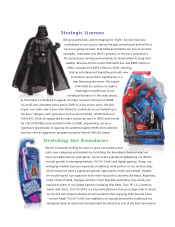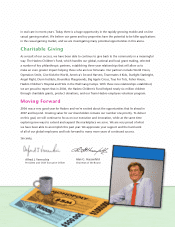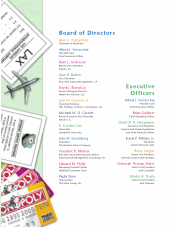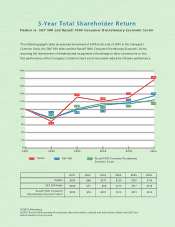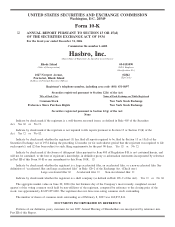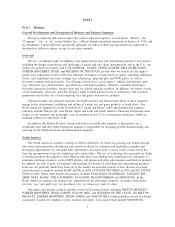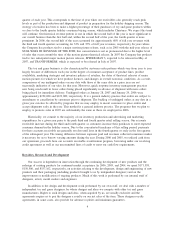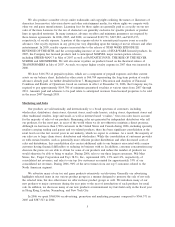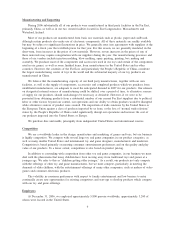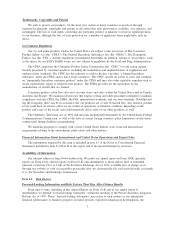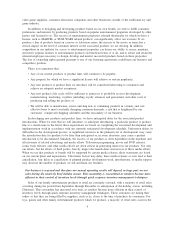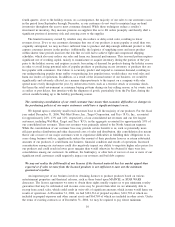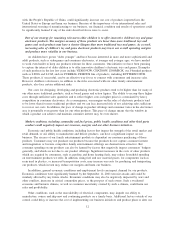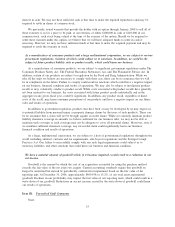Hasbro 2006 Annual Report Download - page 17
Download and view the complete annual report
Please find page 17 of the 2006 Hasbro annual report below. You can navigate through the pages in the report by either clicking on the pages listed below, or by using the keyword search tool below to find specific information within the annual report.
Manufacturing and Importing
During 2006 substantially all of our products were manufactured in third party facilities in the Far East,
primarily China, as well as in our two owned facilities located in East Longmeadow, Massachusetts and
Waterford, Ireland.
Most of our products are manufactured from basic raw materials such as plastic, paper and cardboard,
although certain products also make use of electronic components. All of these materials are readily available
but may be subject to significant fluctuations in price. We generally enter into agreements with suppliers at the
beginning of a fiscal year that establish prices for that year. For this reason, we are generally insulated, in the
short-term, from increases in the prices of raw materials. However, severe increases in the prices of any of
these materials may require renegotiation with our suppliers during the year. Our manufacturing processes and
those of our vendors include injection molding, blow molding, spray painting, printing, box making and
assembly. We purchase most of the components and accessories used in our toys and certain of the components
used in our games, as well as some finished items, from manufacturers in the United States and in other
countries. However, the countries of the Far East, and particularly the People’s Republic of China, constitute
the largest manufacturing center of toys in the world and the substantial majority of our toy products are
manufactured in China.
We believe that the manufacturing capacity of our third party manufacturers, together with our own
facilities, as well as the supply of components, accessories and completed products which we purchase from
unaffiliated manufacturers, are adequate to meet the anticipated demand in 2007 for our products. Our reliance
on designated external sources of manufacturing could be shifted, over a period of time, to alternative sources
of supply for our products, should such changes be necessary or desirable. However, if we were to be
prevented from obtaining products from a substantial number of our current Far East suppliers due to political,
labor or other factors beyond our control, our operations and our ability to obtain products would be disrupted
while alternative sources of product were secured. The imposition of trade sanctions by the United States or
the European Union against a class of products imported by us from, or the loss of “normal trade relations”
status by, the People’s Republic of China could significantly disrupt our operations and increase the cost of
our products imported into the United States or Europe.
We purchase dies and molds, principally from independent United States and international sources.
Competition
We are a worldwide leader in the design, manufacture and marketing of games and toys, but our business
is highly competitive. We compete with several large toy and game companies in our product categories, as
well as many smaller United States and international toy and game designers, manufacturers and marketers.
Competition is based primarily on meeting consumer entertainment preferences and on the quality and play
value of our products. To a lesser extent, competition is also based on product pricing.
In addition to contending with competition from other toy and game companies, in our business we must
deal with the phenomena that many children have been moving away from traditional toys and games at a
younger age. We refer to this as “children getting older younger.” As a result, our products not only compete
with the offerings of other toy and game manufacturers, but we must compete, particularly in meeting the
demands of older children, with the entertainment offerings of many other companies, such as makers of video
games and consumer electronic products.
The volatility in consumer preferences with respect to family entertainment and low barriers to entry
continually create new opportunities for existing competitors and start-ups to develop products which compete
with our toy and game offerings.
Employees
At December 31, 2006, we employed approximately 5,800 persons worldwide, approximately 3,200 of
whom were located in the United States.
6


